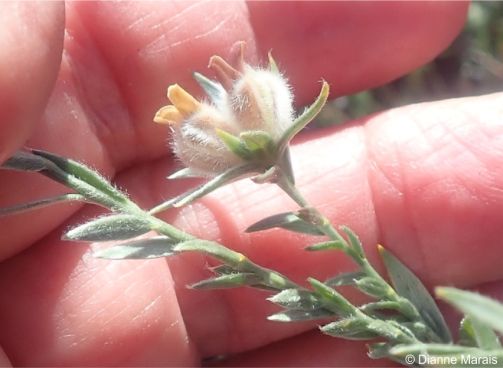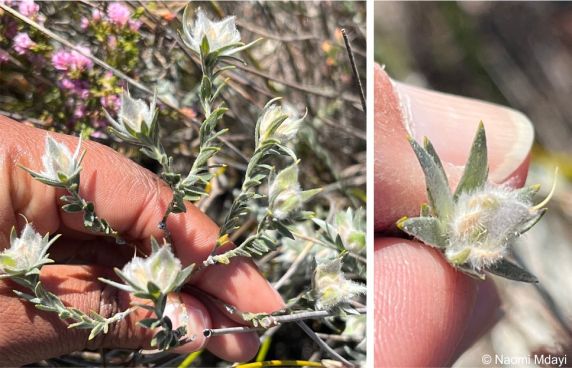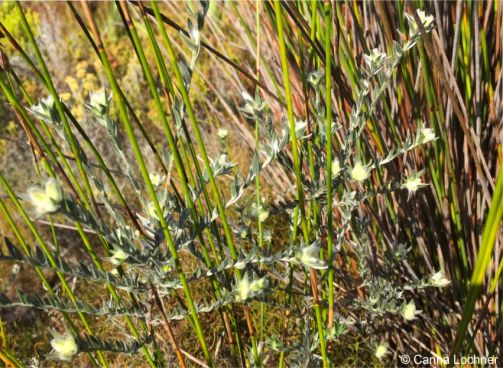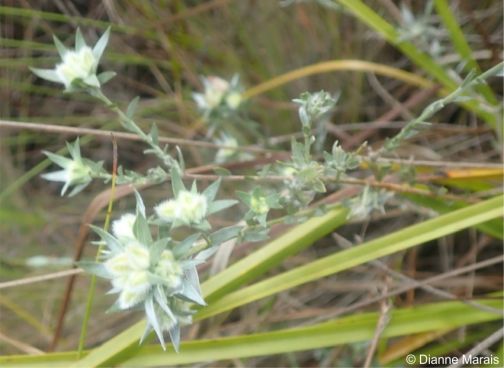Amphithalea tomentosa
Amphithalea tomentosa (Thunb.) Granby
Family: Fabaceae
Common names: hairy amphithalea
Introduction
Ampithalea tomentosa is a striking plant found in Lowland Fynbos, with eye-catching, silvery foliage and yellow blossoms almost hidden by the hairy calyx, in autumn, winter and spring.

Description
Description
Amphithalea tomentosa is a low-growing, resprouting, virgate, silvery grey shrub growing up to 1 m tall. Branches are erect or ascending, woody and mostly bare below. Branchlets patently curved, appressed pubescent. The leaves are lanceolate, acute, flat with slightly recurved margins and silky canescent on both sides. The inflorescences are 2-flowered, the flowers are subsessile and enclosed by the large, hairy, silky calyx. The flowers are small, lemon-yellow to greenish-yellow. They are aggregated at the end of the branchlets with the petals almost hidden by the calyx. Calyx fulvous, villous; calyx lobes triangular, acute, villous, upper lobes medially fused from their apices, lower lobes subequal. Pods ovate, inflated and sericeous. Seeds oblong-reniform, with an elliptic hilum surrounded by a thick, fleshy, collar-like aril.

Conservation Status
Status
According to the Red List of South African Plants, the population trend of Amphithalea tomentosa is declining due to coastal development and invasive alien plants in its habitat. As a result, the plant is assessed as Near Threatened (NT). It is fortunate that the Millennium Seed Bank in South Africa, in the Western Cape to be specific, has collected the seeds of this species to be banked for long term storage and kept as a backup for possible restoration projects in future. You will mostly find it in bloom in autumn, winter and spring, from around April until September.

Distribution and habitat
Distribution description
This species is present in several localities around the Hottentot Holland mountains stretching around Kogel Bay, Hangklip, Betty’s Bay and Kleinmond. There are records of this species near Elim at Rietfontein, which is the western part of Soetanysberg, and at Brandfontein near Riversdale. This plant grows in Lowland Fynbos, mainly on lower mountain slopes, in coastal vegetation and on sandy flats between limestone ridges. It is found among species of Protea, Restio and Erica.

Derivation of name and historical aspects
History
The name Amphithalea is derived from the Greek amphi, meaning ‘around’ and thallos, meaning ‘a green stalk’, meaning ‘flowering all round the stem’. The species name tomentosa is Latin and means ‘densely covered with short hairs’.
Amphithalea tomentosa belongs to the group of papilionaceous legumes in the legume family and is endemic to the Cape Floristic Region of South Africa. There are 42 species in the genus Amphithalea. This genus traditionally formed part of the tribe Liparieae or subtribe Lipariinae, on account of the fused stamens. Relationships amongst the genera of the Liparieae and of the closely affiliated tribe Podalyrieae (where the stamens are free or almost free to the base) were found to be monophyletic. This makes Amphithalea related to these tribes despite these differences in the stamens.
The Liparieae were then synonymized under the Podalyrieae, which has two recognized subtribes: Xiphothecinae, which included Xiphotheca , Amphithalea, and Coelidium, and Podalyriinae, which included Liparia, Podalyria, Stirtonanthus, Virgilia and Calpurnia. There were some difficulties in separating the two genera: Amphithalea and Coelidium. Even experienced botanists had great difficulty in telling them apart. The only difference between them lies in the free or fused stamens. This character was regarded as significant and maintained the separation of these genera until Schutte’s 1998 phylogenetic study showed that Coelidium is nested within Amphithalea and thus Coelidium is now reduced to synonymy under Amphithalea.

Ecology
Ecology
Plants in this group of legumes, including Amphithalea , have evolved differently structured flowers and flower heads in response to different pollination syndromes. The erect, decussate inflorescences or pendant, proteoid heads indicate adaptations to various pollinaters. For example, the flowers that are firmly textured and have a short and upwardly direct keel tip are adapted for pollination by xylocopid bees, while those with a long and forwardly directed beak are for pollination by birds and possibly rodents. Amphithalea tomentosa is pollinated by bees foraging for nectar.
It is largely argued that this genus consists of resprouters or that species have adaptive responses to fire, as have most fynbos species. Amphithalea tomentosa is a resprouter, and although the plant may be burned in a fire, the rootstock usually survives and it sends out new shoots after the fire.
This species has inflated seed pods and release seeds by means of an explosive mechanism. Seeds have a thick, fleshy, collar-like aril that is a mechanism for seed dispersal by ants. For a successful seed collection of this species and most legumes, the Millennium Seed Bank Partnership uses a bagging system whereby transparent collecting bags are carefully placed over the inflorescence to cover the seed pods on the plant before they reach their optimum seed dispersal time. The bag will thus trap the seeds and prevent them from being shot away after the pod opens explosively, or being carried off by ants.

Uses
Use
This plant has no medicinal or cultural uses but could make a great contribution to the horticultural and landscaping industries; it may make a rewarding pot plant, its silvery foliage makes it stand out in gardens, and it could be planted with colourful and bright plants. Ampithalea tomentosa is best in fynbos gardens.
Growing Amphithalea tomentosa
Grow
This shrub is quite challenging to grow, and the best results are achieved by copying its natural habitat requirements, just like most Amphithalea and Liparia species. It is fond of damp, acidic soils and needs lots of water in the winter months. It is best to grow it in flower beds in full sun or half-day shade with larger plants protecting it. Feed with a slow-release organic fertilizer and apply mulch of well-rotted compost in spring and autumn. As fire is suspected to rejuvenate older plants, mimic this by cutting the old woody stems, in the summer months, back to the rootstock and leave a few younger stems to sustain the plant.
Ampithalea tomentosa can be propagated by both seeds and cuttings. Numerous seed pretreatments are recommended to enhance germination outcomes. Subsequently after matured seeds which are naturally dispersed are collected, it is recommended to dry the seeds in silica at 18°C and 15% relative humidity for a few months. Prior to sowing, seeds must be scarified to break dormancy by directly removing the seed coat. This can be achieved by either using sandpaper to remove each seed or by using a scalpel or blade to remove the seed coat. Scientists and researchers at Kirstenbosch National Botanical Garden most often smoke the seeds using the smoke tent method or they soak seeds in smoke water solution overnight for 23-48 hours prior to sowing. A viability test using a Tetrazolium Staining Test, Seed float test and testing seed vigour using Accelerated Aging are recommended.
Seeds should be sown during the cool periods to achieve optimal conditions, preferably in autumn, late spring, or early summer. Next seeds must be sown in well-draining soil medium, preferably sandy, and kept at an optimum temperature. Germination can take up to 4-5 weeks or less, monitoring is recommended as ungerminated seeds can get mouldy.
Semi-hardwood cuttings can be taken in late summer, autumn, and spring. Disease-free and insect-free plant material should be selected after flowering. Thin and new shoots at the base should always be first choice for taking propagating material from. The appropriate rooting hormone or root stimulants are required to stimulate and accelerate the rooting process. Overwatering and areas with high relative humidity are not ideal to place cuttings as they may cause the cuttings to suffer from root rot or other fungal diseases. Moreover, in the early stages of taking cuttings, direct sunlight should be avoided to minimize plant shock and fatality.
References
- Bos, J.J. 1967. The genus Liparia L. (Pap). Journal of South African Botany 33(4):269-292.
- Brown, N.A.C., Prosch, D.S. & Botha, P.A. 1998. Plant derived smoke: an effective pre-treatment for seeds of Syncarpha and Rhodocoma and potentially for many other Fynbos species. South African Journal of Botany 64(1): 90–92.
- Granby, R. 1985. Revision of the genus Amphithalea (Liparieae-Fabaceae). Opera Botanica 80:5-34. Council for Nordic Publications in Botany.
- Jackson, W.P.U. 1990. Origins and meanings of names of South African plant genera. University of Cape Town.
- Lochner, C. 2019. Observation of Ampithalea tomentosa, Steenbras Nature Reserve, Western Cape. iNaturalist. Online. https://www.inaturalist.org/observations/22329604.
- Marais, D. 2023. Observation of Ampithalea tomentosa, Karwyderskraal, Overberg, Western Cape. iNaturalist. Online. https://www.inaturalist.org/observations/160035648.
- Marais, D. 2023. Observation of Ampithalea tomentosa, Volmoed, Overstrand, Western Cape. iNaturalist. Online. https://www.inaturalist.org/observations/159394093.
- Mdayi, N. 2022. Observation of Ampithalea tomentosa, Steenbras Nature Reserve, Cape Town, Western Cape. iNaturalist. Online. https://www.inaturalist.org/observations/133177626.
- Raimondo, D. 2008. Amphithalea tomentosa (Thunb.) Granby. National Assessment: Red List of South African Plants version 2020.1. Accessed on 2023/12/05.
- Schnitzler, J. 2009. Biotic interactions and species diversification in southern African biodiversity hotspots. Thesis submitted for Doctor of Philosophy Division of Biology, Imperial College London.
- Schutte, A.L. 1998. A re-evaluation of the generic status of Amphithalea and Coelidium (Fabaceae)Taxon 47(1):55-65.
- Schutte, A.L. 1998. A re-evaluation of the generic status of Amphithalea and Coelidium (Fabaceae)Taxon 47(1):55-65.
- Schutte, A.L. & Van Wyk, B.E. 1994. A reappraisal of the generic status of Liparia and Priestleya (Fabaceae). Taxon 43(4):573-582.
Credits
Naomi Mdayi & Sphephelo Kheswa
MSBP
December 2023
Acknowledgements: the authors thank Ndileka Jaxa for assisting with relevant sources to get the information about the plant and Di Marais and Carina Lochner for granting permission for their images to be used in this article.
Plant Attributes:
Plant Type: Shrub
SA Distribution: Western Cape
Soil type: Sandy
Flowering season: Spring, Autumn, Winter
PH: Acid
Flower colour: Yellow
Aspect: Full Sun
Gardening skill: Challenging
Special Features:
Horticultural zones







Rate this article
Article well written and informative
Rate this plant
Is this an interesting plant?
Login to add your Comment
Back to topNot registered yet? Click here to register.